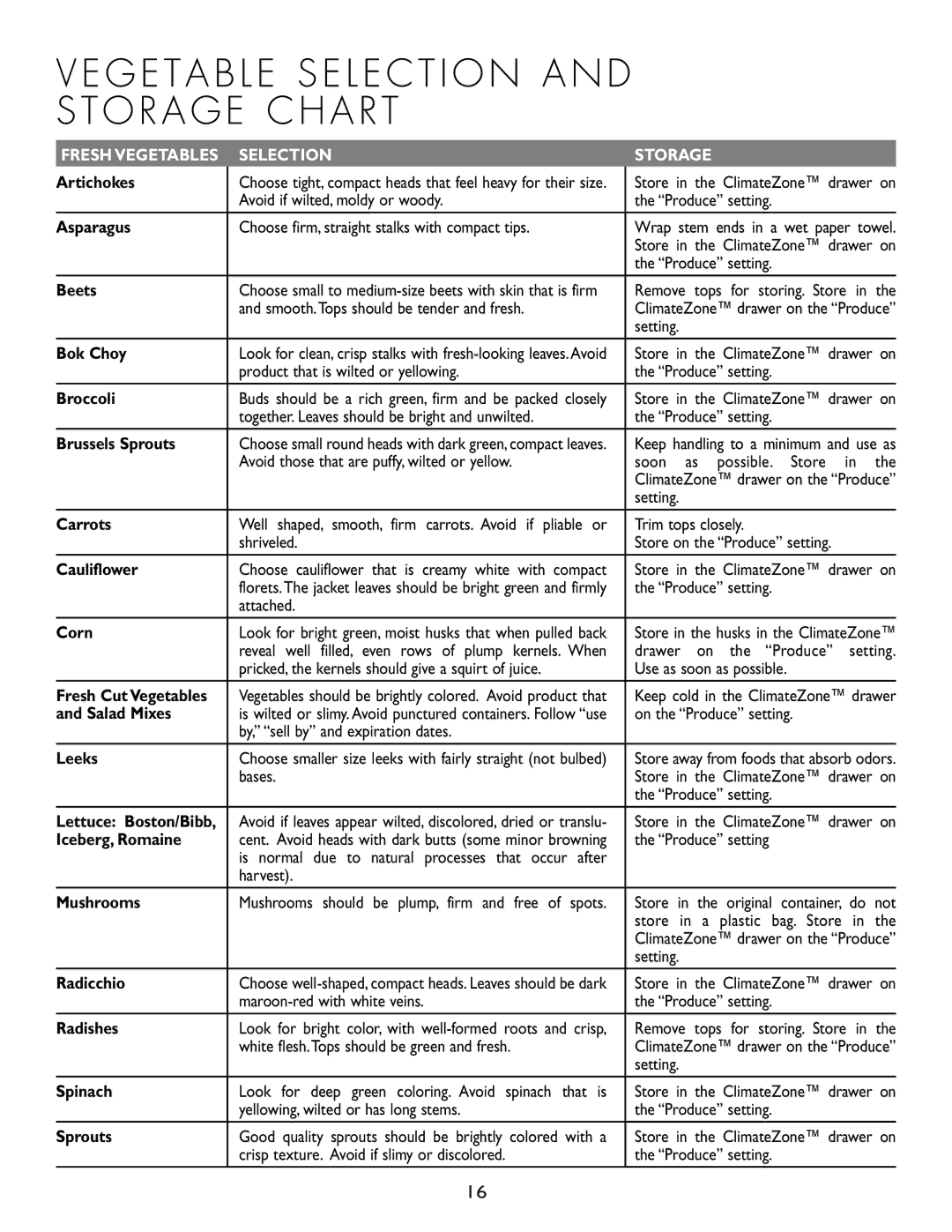V E G E T A B L E S E L E C T I O N A N D
S T O R A G E C H A R T
FRESH VEGETABLES | SELECTION | STORAGE |
Artichokes | Choose tight, compact heads that feel heavy for their size. | Store in the ClimateZone™ drawer on |
| Avoid if wilted, moldy or woody. | the “Produce” setting. |
Asparagus | Choose firm, straight stalks with compact tips. | Wrap stem ends in a wet paper towel. |
|
| Store in the ClimateZone™ drawer on |
|
| the “Produce” setting. |
Beets | Choose small to | Remove tops for storing. Store in the |
| and smooth.Tops should be tender and fresh. | ClimateZone™ drawer on the “Produce” |
|
| setting. |
Bok Choy | Look for clean, crisp stalks with | Store in the ClimateZone™ drawer on |
| product that is wilted or yellowing. | the “Produce” setting. |
Broccoli | Buds should be a rich green, firm and be packed closely | Store in the ClimateZone™ drawer on |
| together. Leaves should be bright and unwilted. | the “Produce” setting. |
Brussels Sprouts | Choose small round heads with dark green, compact leaves. | Keep handling to a minimum and use as |
| Avoid those that are puffy, wilted or yellow. | soon as possible. Store in the |
|
| ClimateZone™ drawer on the “Produce” |
|
| setting. |
Carrots | Well shaped, smooth, firm carrots. Avoid if pliable or | Trim tops closely. |
| shriveled. | Store on the “Produce” setting. |
Cauliflower | Choose cauliflower that is creamy white with compact | Store in the ClimateZone™ drawer on |
| florets. The jacket leaves should be bright green and firmly | the “Produce” setting. |
| attached. |
|
Corn | Look for bright green, moist husks that when pulled back | Store in the husks in the ClimateZone™ |
| reveal well filled, even rows of plump kernels. When | drawer on the “Produce” setting. |
| pricked, the kernels should give a squirt of juice. | Use as soon as possible. |
Fresh Cut Vegetables | Vegetables should be brightly colored. Avoid product that | Keep cold in the ClimateZone™ drawer |
and Salad Mixes | is wilted or slimy. Avoid punctured containers. Follow “use | on the “Produce” setting. |
| by,” “sell by” and expiration dates. |
|
Leeks | Choose smaller size leeks with fairly straight (not bulbed) | Store away from foods that absorb odors. |
| bases. | Store in the ClimateZone™ drawer on |
|
| the “Produce” setting. |
Lettuce: Boston/Bibb, | Avoid if leaves appear wilted, discolored, dried or translu- | Store in the ClimateZone™ drawer on |
Iceberg, Romaine | cent. Avoid heads with dark butts (some minor browning | the “Produce” setting |
| is normal due to natural processes that occur after |
|
| harvest). |
|
Mushrooms | Mushrooms should be plump, firm and free of spots. | Store in the original container, do not |
|
| store in a plastic bag. Store in the |
|
| ClimateZone™ drawer on the “Produce” |
|
| setting. |
Radicchio | Choose | Store in the ClimateZone™ drawer on |
| the “Produce” setting. | |
Radishes | Look for bright color, with | Remove tops for storing. Store in the |
| white flesh.Tops should be green and fresh. | ClimateZone™ drawer on the “Produce” |
|
| setting. |
Spinach | Look for deep green coloring. Avoid spinach that is | Store in the ClimateZone™ drawer on |
| yellowing, wilted or has long stems. | the “Produce” setting. |
Sprouts | Good quality sprouts should be brightly colored with a | Store in the ClimateZone™ drawer on |
| crisp texture. Avoid if slimy or discolored. | the “Produce” setting. |
16
